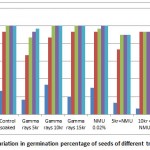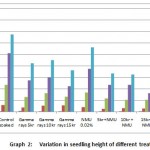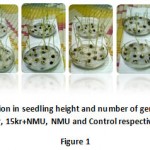How to Cite | Publication History | PlumX Article Matrix
Girraj Singh Meena
Department of Botany, Government P. G. College, Dholpur India.
ABSTRACT: The paper reports the results of application of 5kr, 10kr and 15kr of gamma rays and/ or 0.02% of Nitroso Methyl Urea ( NMU ) on Khesari ( Lathyrus sativus ) var. P-24. Germination, seedling growth and chlorophyll content were adversely affected in all the treatments. Simultaneous treatment with two mutagens was more effective than the single treatment with either mutagen. Results indicated variation for seed germination, seedling growth and chlorophyll content. The seeds treated with 5kr + NMU and 10kr + NMU showed minimum germination. Minimum seedling height was observed in seeds treated with 15kr + NMU (50 mm) on the 15th day after sowing. A little variation in chlorophyll content was also observed. Certain morphological variations were induced in all the treatments.
KEYWORDS: Lathyrus sativus; Gamma rays; NMU; Induced mutation
Download this article as:| Copy the following to cite this article: Meena G. S. Effects of Physical and Chemical Mutagens on Seed Germination and Seedling Growth in Khesari [Lathyrus sativus ] var.- P-24. Biosci Biotech Res Asia 2011;8(2) |
| Copy the following to cite this URL: Meena G. S. Effects of Physical and Chemical Mutagens on Seed Germination and Seedling Growth in Khesari [Lathyrus sativus ] var.- P-24. Biosci Biotech Res Asia 2011;8(2). Available from: https://www.biotech-asia.org/?p=9824 |
Introduction
Mutation is caused by physical as well as chemical mutagens in plants. These mutagens cause certain deleterious effects in biological systems in addition to the induction of mutations. Some of the main effects observed in the experiments involving seed treatment were reduced germination percentage and retarded seedling growth. Mutagenic changes in grass pea are involving chromosomal anomalies, chlorophyll deficiencies and different types of phenotypic modifications ( Prasad and Das, 1980; Waghmare, et al., 2001; Rybinski, 2003 ). The present study reports the effects of gamma rays as a physical mutagen and NMU (0.02%) as a chemical mutagen. There were nine different seed treatments involving both gamma rays and NMU. The observation of variations were based on seed germination and seedling growth in Khesari (Lathyrus sativus) var.-P-24.
Material and Method
Dry and dormant seeds of grass pea var. P-24 were subjected to gamma irradiations at the Nuclear Research Lab IARI New Delhi. Three different dosage of gamma rays 5kr, 10kr and 15kr were applied. There were 300 seeds of each radiation dose. 150 seeds from each radiation treatment and 150 fresh untreated seeds were soaked in 0.02% NMU solution for six hours. Thus there were eight treatment combinations including the untreated control. Fifty seeds from each treatment were used for laboratory work. In this experiment 50 seeds soaked in distilled water for six hours served as an additional control. Observations with regard to germination and seedling height were recorded at a regular interval of three days from the date of sowing and were continued up to the fifteenth day from sowing. Total height of seedlings was measured from the surface of the soil to the tip of the shoot apex. Finally observations with regard to germination and seedling growth were subjected to analysis of variance.
Result and Discussion
Observations on germination percentage and total height of seedlings have been summarized in table 1 and graphically shown in figures 1 and 2. It is evident from the figure that the germination percentage was varied in all the treatments including soaked in distilled water. Germination percentage of normal soaked and normal unsoaked control seeds were observed as 26.6 % and 46.6 % on the 3rd day after sowing. In treated seeds with 5kr gamma rays + NMU ( 0.02 % ) germination was only13.3 % which was recorded as lowest germination percentage on the 3rd day after sowing. Germination percentage of both types of normal seeds were 100 % on the 15th day after sowing while seeds treated with 5kr gamma rays + NMU and 10kr gamma rays + NMU were observed as 90% and 93% respectively.
A great variation in seedling height was also observed in different treatments.On the 15th day of germination unsoaked control had an average seedling height of 155mm while 15 kr + NMU had an average seedling height of only 50 mm. A little variation in chlorophyll content was
Table 1: Summarizing the effect of Gamma rays and NMU on germination and seedling height in Khesar
|
Treatment |
Germination % | Seedling height (mm) | ||||||||
| Days after sowing | days after sowing | |||||||||
| 3 | 6 | 9 | 12 | 15 | 3 | 6 | 9 | 12 | 15 | |
| Control unsoaked | 46.6 | 93.33 | 100 | 100 | 100 | 1.75 | 11 | 57.5 | 115 | 155 |
| Control soaked | 26.6 | 93.33 | 100 | 100 | 100 | 1.5 | 12 | 47.5 | 102.5 | 135 |
| Gamma rays 5kr | 16.6 | 66.6 | 86.6 | 93.3 | 96.66 | 2 | 8 | 26 | 55 | 85 |
| Gamma rays 10kr | 33.3 | 86.66 | 100 | 100 | 100 | 1.5 | 11 | 32.5 | 60 | 90 |
| Gamma rays 15kr | 20 | 93.33 | 100 | 100 | 100 | 1.25 | 11.5 | 26.5 | 45 | 72.5 |
| NMU 0.02% | 30 | 93.33 | 96.6 | 100 | 100 | 0.75 | 8.5 | 34 | 75 | 112.5 |
| 5kr+NMU | 13.3 | 73.33 | 90 | 90 | 90 | 1.5 | 5.5 | 23.5 | 47.5 | 67.5 |
| 10kr+ NMU | 6.66 | 93.33 | 93.3 | 93.3 | 93.33 | 1.5 | 6.5 | 21 | 47.5 | 65.5 |
| 15kr+ NMU | 16.6 | 90 | 96.6 | 96.6 | 96.66 | 1.25 | 6 | 21.5 | 32.5 | 50 |
 |
Graph 1: Variation in germination percentage of seeds of different treatments.
|
 |
Graph 2: Variation in seedling height of different treatments.
|
 |
Figure 1
|
The photographs showing variation in seedling height and number of germinated seeds treated with 5kr, 5kr+NMU, 10kr, 10kr+NMU, 15kr, 15kr+NMU, NMU and Control respectively ( from left to right).
also observed on the 9th day of sowing. Seedlings of 5kr had samechlorophyll content as normal seedlings. 10kr, 15kr and combined treatment of 5kr+ NMU and 10kr+ NMU had low chlorophyll content than normal seedlings,while 15kr+NMU treated seedlings observed with minimum chlorophyll content on the 9th day of sowing. Haque (1976) noted a dose dependent reduction in the germination percentage following gamma rays treatments of soybean seeds. Among other leguminous crops reduction in germination percentage following by mutagenic treatments has been recorded in Pisum (Ehrenberg, 1955; Blixit, 1960 and Blixit et al. 1963 ); groundnut (ShivRaj et al, 1962 ); mungbean( Ashraj et al, 1975 ); cowpea ( Ojomoo Raji, 1978 ); pigeon pea( Haque et al, 1981 ) and lentil ( Dixit and Dubey, 1981 ).
Besides reduction in germination percentage, delayed germination was also observed in some treatments. The soaked control, unsoaked control, soaked control and the seeds which are treated with different dosage of gamma rays and NMU showed maximum germination on 6th day of sowing where as in the seeds which are treated with 5kr (gamma rays) and 5kr + NMU maximum germination was observed on the 9th day of sowing. Those seeds which are treated with 5kr or NMU showed continuous germination till 12th day of showing.
The seedling height in both type of controls was found to be more than that of mutagenically treated seeds. A dosedependent retardation in seedling growth is a common feature induced by chemical as well as physical mutagens ( Caldecott, 1954; Sharma, 1968; Blixit et al, 1963; Goud, 1967; Conger et al, 1973; Singh et al, 1977 and Dixit, 1985). According to Gunkel ( 1965 ), growth retardation may be caused by growth inhibition due to destruction of apical meristem or partial failure of internode elongation. Radiation induced depression in seedling height has been attributed to auxins destruction ( Smith and Kerstem, 1942), inhibition of auxins synthesis ( Gorden and Webber, 1950) and chromosomal damage or mitotic inhibition ( Sparrow et al, 1952 ).
References:-
- Ashraj, Y.;K. Alam; H. Yousaf (1975) Pakistan Jour.Agric. Sci. 12 : 259.
- Blixit, S. (1960) Agric.Hort.Genet. 18:219.
- Blixit, S.; L. Ehrenberg; and O. Gelin (1963) Hort Genet. 21 : 178.
- Caldecott, R. S. (1954) Science, 20 : 809.
- Conger, B. V.; D. D. Killion and M. J. Constantin (1973) Bot. 13 : 173.
- Dixit, P. and D. K. Dubey (1981) Botanical Progress 4 : 10.
- Ehrenberg, L. (1955) Botaniska Notiser, 108 : 184.
- Goud, J. V. (1967) Indian J. Genet. 27 : 40.
- Gorden, S. A. and Webber,R. P. (1950) J. Bot. 37 : 637.
- Gunkel, J. E.(1965) ‘’Encyclopedia of plant physiol’’ 15 pt. 2 : 365.
- Haque, M. D. F.; C. M. Sharma and R. Prakash (1981) Pulse Crops News Letter, 1(2) : 17.
- Ojomoo, O. A.and J. A. Raji (1978) Grain Legume Bull. 13/14 : 11
- Prasad,A.B; Das,A.K. (1980). Morphological variants in Khesari. Indian.J.Genet.40: 172-175
- Rybinski,W (2003 ). Mutagenesis as a tool for improvements of traits in grass pea.Lathyrism News. Let; 3: 30-34
- Shiv Raj, A.; N. G. P. Rao; B. V. Ramana and H. A. Fazvi 99162) Indian Oil Seeds J. 6 : 24.
- Smith, J. F. and H. Kerstem (1942) Physiol. 17 : 455.
- Sparrow, A. H.; M. J. Moses and R. Dubow (1952) Cell Res. 2 (Suppl) : 245.
- Waghmare, V.N; Waghmare, D.N; Mehara, R.B (2001 ). An induced fascinated mutant in grass pea; J. Genet; 61: 155-157.

This work is licensed under a Creative Commons Attribution 4.0 International License.





